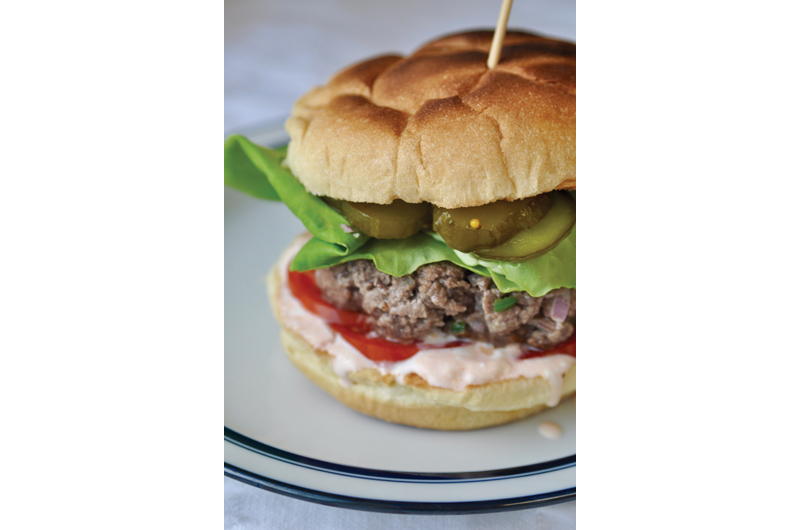Meat eaters should be curious about venison for a variety of reasons, even if the hunting part doesn’t personally entice them. The most obvious benefit is that hunting deer helps to decrease the debilitating tick-borne diseases the animals carry. Fewer deer, fewer ticks. From a nutritional standpoint, fresh venison meat is an attractive option too, offering high doses of protein and iron and low amounts of fat and cholesterol. But what about cooking venison at home? What’s the flavor, texture, and versatility like?
Venison is a slightly mysterious ingredient, so I wanted to talk to someone who is personally connected to Island venison – someone who cooks and eats it on a regular basis and could make the whole process relatable. My friend Beth Seabourne was the obvious (and after chatting with her at length, perfect) choice. Beth grew up out West where her father still runs a small working ranch in central Montana. Hunting and eating wild deer, elk, rabbits, and fish has been a part of her family dynamic her whole life. Beth remembers her dad going to “camp” for a few weeks at a time every year and returning with all kinds of cuts of meat. It’s no surprise Beth fell in love with an avid hunter, her husband Billy – she must have felt right at home.
Billy has been hunting since he was twelve years old and has always hunted only what he can eat – though he can eat venison daily, Beth assures me. After hearing how Beth cooks their venison at home, I can understand why: she has mastered a collection of familiar yet surprising recipes using up the variety of cuts (tenderloin, backstrap, fillet, stew meat, ground burger) that Billy brings home each year. “Island venison has an amazing flavor,” Beth says. “Most of the venison from my childhood was gamey, lean, and sage-brushy.”
But how does that butchered meat get into their (and possibly your) West Tisbury freezer and ultimately onto the family dinner table? Billy hunts on the Vineyard with a group of eight to ten guys and together they aim for thirty deer a year. The hunters are a mix of Island chefs and outdoorsmen, all with the same goal – to butcher and use every single piece of the animals. Once the deer are butchered, each hunter brings home a variety of cuts. “We start the season with four grocery bags full of butchered venison,” Beth says. “Most of it goes right into our freezer and we slowly chip away at it. Our family loves it – thankfully! – and not having to buy meat, unless we want to, is a huge savings.”
This is not to say that Beth hasn’t found cooking Vineyard venison at home to sometimes be a challenge. “I had a full leg of deer in my freezer,” she remembers. Luckily, the leg had a happy ending. On Christmas Eve Beth’s brother Dan Sauer, the chef and owner of 7a Foods in West Tisbury and Sea Smoke in Oak Bluffs, made venison confit for their large family. “The deer leg went from the scariest part to the most delicious venison meal we’ve ever had.”
If you don’t have a professional chef in the family, you can still make a variety of delicious home-cooked venison meals. Beth recommends starting with yogurt burgers (recipe at right), a simple bolognese (served over greens or pasta), venison meatballs (great for lunches), or pulled venison in the slow cooker. To make pulled venison, a Seabourne family favorite, simply add brown sugar, vinegar, salt, pepper, and Beth’s secret ingredient, whiskey, to a slow cooker; pull the tender venison in its juices before serving. This is a good technique to use up scraps.
Roasting fillets or a backstrap cut are favorite Sunday dinner options. First sear a seasoned fillet in a hot skillet, then roast it until medium rare and serve alongside seasonal vegetables. Before roasting the backstrap cut, Beth suggests marinating it in whiskey (are you noticing a theme here?) to tenderize the meat. Surround the backstrap roast with fruit or berries before popping it into a hot oven.
You may not have an avid hunter in your own family, but this is a small Island. If you’re interested in cooking and eating Vineyard venison, start asking around – word of mouth is the best way to find a hunter. Experiment in your kitchen, ask questions, trade cuts of venison for freshly baked bread, eggs, or homemade jams. If an old-fashioned local food swap doesn’t sound like the classic Vineyard way, then I don’t know what does.
The following recipe was originally published along with this article:







